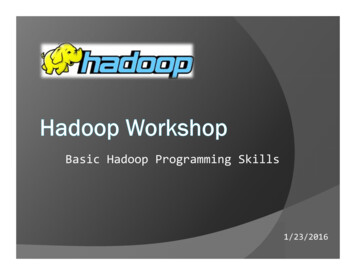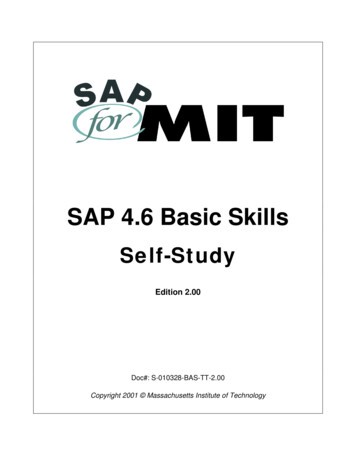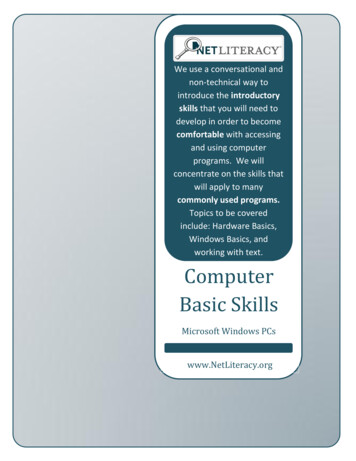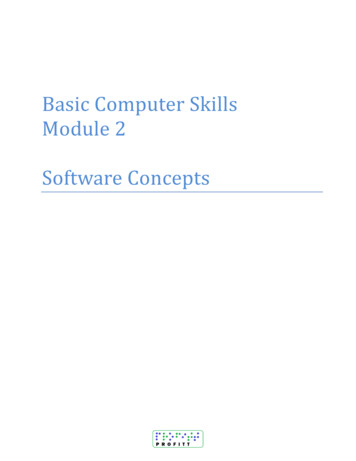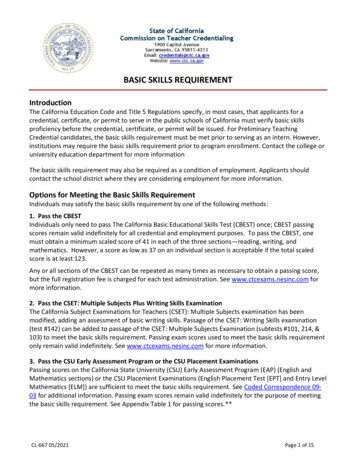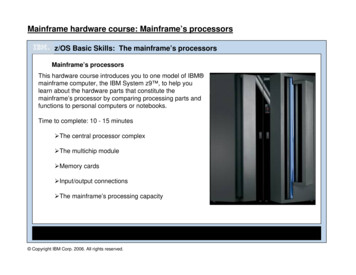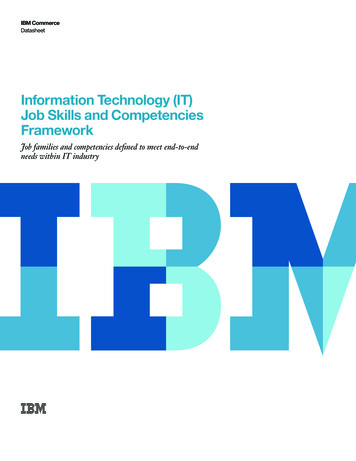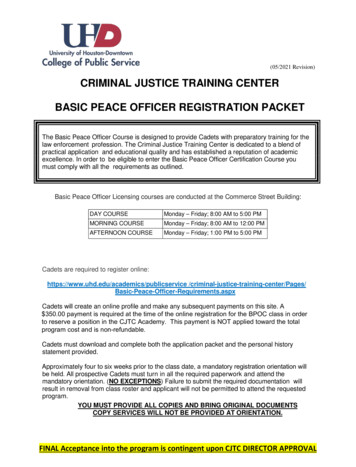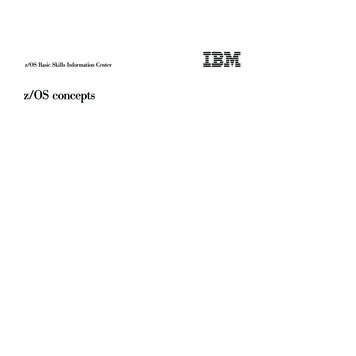
Transcription
z/OS Basic Skills Information Centerz/OS concepts
z/OS Basic Skills Information Centerz/OS concepts
NoteBefore using this information and the product it supports, read the information in “Notices” on page 107.This edition applies to z/OS (product number 5694-A01).We appreciate your comments about this publication. Comment on specific errors or omissions, accuracy,organization, subject matter, or completeness of this book. The comments you send should pertain to only theinformation in this manual or product and the way in which the information is presented.For technical questions and information about products and prices, contact your IBM branch office, your IBMbusiness partner, or your authorized remarketer.When you send comments to IBM, you grant IBM a nonexclusive right to use or distribute your comments in anyway it believes appropriate without incurring any obligation to you. IBM or any other organizations will only usethe personal information that you supply to contact you about the issues that you state on this form.Send your comments through this Web site: v1r7/index.jsp?topic /com.ibm.zcontact.doc/webqs.html Copyright IBM Corporation 2006, 2010.US Government Users Restricted Rights – Use, duplication or disclosure restricted by GSA ADP Schedule Contractwith IBM Corp.
ContentsIntroduction to z/OS . . . . . . . . . vChapter 3. Interacting with z/OS: TSO,ISPF, and z/OS UNIX interfaces . . . . 59Chapter 1. z/OS operating system:Providing virtual environments since the1960s . . . . . . . . . . . . . . . . 1What is TSO?. . . . . . . . .What is TSO native mode? . . .How are CLISTs and REXX used? .What is ISPF? . . . . . . . .ISPF keyboard keys and functions .The ISPF Data Set List utility . .The ISPF editor . . . . . . .The ISPF Settings menu . . . .What is z/OS UNIX? . . . . . .ISHELL command (ish) . . . .OMVS command shell session . .Direct login to the z/OS UNIX shellHardware resources used by z/OS . . . . . .Multiprogramming and multiprocessing . . . .z/OS programming constructs: Modules, macros,components and control blocks . . . . . . .Physical storage used by z/OS . . . . . . .What is virtual storage? . . . . . . . . .What is an address space? . . . . . . . .What is dynamic address translation? . . . .How z/OS uses physical and virtual storage .The role of storage managers . . . . . .A brief history of virtual storage and 64-bitaddressability. . . . . . . . . . . .What is meant by “below-the-line” storage? .What's in an address space? . . . . . . .System address spaces and the master schedulerWhat is workload management? . . . . . .I/O and data management . . . . . . . .Supervising the execution of work in the system .What is interrupt processing? . . . . . .Dispatchable units of work: Tasks and servicerequests . . . . . . . . . . . . .Preemptable versus non-preemptable units ofwork . . . . . . . . . . . . . .What does the dispatcher do? . . . . . .Serializing the use of resources . . . . . .Defining characteristics of z/OS . . . . . .Additional software products for z/OS . . . .Middleware for z/OS . . . . . . . . . .A brief comparison of z/OS and UNIX . . . . 1. 3. 3. 4. 5. 6. 7. 7. 12. 13. 17. 1719. 20. 22. 22. 23. 25.26272830313232.596062626668697172747576Chapter 4. Processing work on z/OS:How the system starts and managesbatch jobs . . . . . . . . . . . . . 79What is batch processing? . . .What is JES? . . . . . . . .What does an initiator do? . . .Batch processing and JES: Scenario 1Batch processing and JES: Scenario 2Job flow through the system . . .JES2 compared to JES3. . . . .79808283888991Chapter 5. Doing work on z/OS: Howyou submit, control and monitor jobsusing JCL and SDSF. . . . . . . . . 93What is JCL? . . . . . . . . . . . . .How is a job submitted for batch processing? . .What is the System Display and Search Facility(SDSF)?. . . . . . . . . . . . . . . 93. 95. 95Chapter 2. z/OS storage constructs:File systems, data sets, and more . . . 35Chapter 6. Parallel Sysplex: Worth theeffort for continuous availability . . . 101What is a data set? . . . . . . . . . .Quick reference: Data set structure. . . .Where are data sets stored? . . . . . .What are access methods? . . . . . .What are DASD volumes and labels? . . .Allocating a data set . . . . . . . .Types of data sets . . . . . . . . .What happens when a data set runs out ofspace? . . . . . . . . . . . . .What is VSAM? . . . . . . . . . .What is a VTOC? . . . . . . . . . .What is a catalog? . . . . . . . . .What is a generation data group? . . . .Role of DFSMS in managing space . . .z/OS UNIX file systems . . . . . . . .z/OS data sets versus file system files . .What is a zFS file system? . . . . . .Benefits of Parallel Sysplex: No single points offailure . . . . . . . . . . . . . . .Benefits of Parallel Sysplex: Capacity and scalingBenefits of Parallel Sysplex: Dynamic workloadbalancing . . . . . . . . . . . . . .Benefits of Parallel Sysplex: Ease of use . . .Benefits of Parallel Sysplex: Single system imageBenefits of Parallel Sysplex: Compatible changeand non-disruptive growth . . . . . . . .Benefits of Parallel Sysplex: Applicationcompatibility . . . . . . . . . . . .Benefits of Parallel Sysplex: Disaster recovery . Copyright IBM Corp. 2006, 2010.36373838394044.474849505353555657. 101102. 102. 103104. 105. 105. 106Notices . . . . . . . . . . . . . . 107Programming interface information .Trademarks . . . . . . . . . 108. 109iii
ivz/OS Basic Skills Information Center: z/OS concepts
Introduction to z/OSAs a technical professional, you need a general understanding of the mainframecomputer and its place in today's information technology (IT) organization. z/OSconcepts is a collection of articles that provides the background knowledge andskills necessary to begin using the basic facilities of a mainframe computer.For optimal learning, readers are assumed to have successfully completed anintroductory course in computer system concepts, such as computer organizationand architecture, operating systems, data management, or data communications.They should also have successfully completed courses in one or moreprogramming languages, and be PC literate.Readers who will benefit from this collection of articles include data processingprofessionals who have experience with non-mainframe platforms, or who arefamiliar with some aspects of the mainframe but want to become knowledgeablewith other facilities and benefits of the mainframe environment. After reading thiscollection, readers will have:v A comprehensive overview of z/OS, a widely used mainframe operating systemv An understanding of mainframe workloads and an overview of the majormiddleware applications in use on mainframes todayv The basis for subsequent course work in more advanced, specialized areas ofz/OS, such as system administration or application programming Copyright IBM Corp. 2006, 2010v
viz/OS Basic Skills Information Center: z/OS concepts
Chapter 1. z/OS operating system: Providing virtualenvironments since the 1960sz/OS is known for its ability to serve thousands of users concurrently and forprocessing very large workloads in a secure, reliable, and expedient manner. Itsuse of multiprogramming and multiprocessing, and its ability to access andmanage enormous amounts of virtual and physical storage as well as I/Ooperations, makes it ideally suited for running mainframe workloads.The concept of virtual storage is central to z/OS. Virtual storage is an illusioncreated by the architecture, in that the system seems to have more storage than itreally has. Virtual storage is created through the use of tables to map virtualstorage pages to frames in central storage or slots in auxiliary storage. Only thoseportions of a program that are needed are actually loaded into central storage.z/OS keeps the inactive pieces of address spaces in auxiliary storage.z/OS is structured around address spaces, which are ranges of addresses in virtualstorage. Each user of z/OS gets an address space containing the same range ofstorage addresses. The use of address spaces in z/OS allows for isolation of privateareas in different address spaces for system security, yet also allows forinter-address space sharing of programs and data through a common areaaccessible to every address space.In common usage, the terms central storage, real storage, real memory, and mainstorage are used interchangeably. Likewise, virtual memory and virtual storage aresynonymous. The amount of central storage needed to support the virtual storagein an address space depends on the working set of the application being used, andthis varies over time. A user does not automatically have access to all the virtualstorage in the address space. Requests to use a range of virtual storage are checkedfor size limitations and then the necessary paging table entries are constructed tocreate the requested virtual storage. Programs running on z/OS and System z mainframes can run with 24-, 31-, or 64-bit addressing (and can switch betweenthese modes if needed). Programs can use a mixture of instructions with 16-bit,32-bit, or 64-bit operands, and can switch between these if needed.Mainframe operating systems seldom provide complete operational environments.They depend on licensed programs for middleware and other functions. Manyvendors, including IBM , provide middleware and various utility products.Middleware is a relatively recent term that can embody several concepts at thesame time. A common characteristic of middleware is that it provides aprogramming interface, and applications are written (or partially written) to thisinterface.Hardware resources used by z/OSMainframe hardware consists of processors and a multitude of peripheral devicessuch as disk drives (called direct access storage devices or DASD), magnetic tapedrives, and various types of user consoles.Tape and DASD are used for system functions and by user programs executed byz/OS. Copyright IBM Corp. 2006, 20101
Figure 1. Hardware resources used by z/OSThe z/OS operating system executes in a processor and resides in processorstorage during execution. z/OS is commonly referred to as the system software.To fulfill a new order for a z/OS system, IBM ships the system code to thecustomer through the Internet or (depending on customer preference) on physicaltape cartridges. At the customer site, a person such as the z/OS systemprogrammer receives the order and copies the new system to DASD volumes.After the system is customized and ready for operation, system consoles arerequired to start and operate the z/OS system.The z/OS operating system is designed to make full use of the latest IBMmainframe hardware and its many sophisticated peripheral devices. Figure 1presents a simplified view of these mainframe concepts:SoftwareThe z/OS operating system consists of load modules or executable code.During the install process, the system programmer copies these loadmodules to load libraries residing on DASD volumes.HardwareThe system hardware consists of all the devices, controllers, and processorsthat constitute a mainframe environment.Peripheral devicesThese include tape drives, DASD, consoles, and many other types ofdevices.Processor storageOften called real or central storage (or memory), this is where the z/OSoperating system executes. Also, all user programs share the use ofprocessor storage with the operating system.As a "Big Picture" of a typical mainframe hardware configuration, Figure 1 is farfrom complete. Not shown, for example, are the hardware control units thatconnect the mainframe to the other tape drives, DASD, and consoles.2z/OS Basic Skills Information Center: z/OS concepts
Multiprogramming and multiprocessingz/OS is capable of multiprogramming, or executing many programs concurrently,and of multiprocessing, which is the simultaneous operation of two or moreprocessors that share the various hardware resources.The earliest operating systems were used to control single-user computer systems.In those days, the operating system would read in one job, find the data anddevices the job needed, let the job run to completion, and then read in another job.In contrast, the computer systems that z/OS manages are capable ofmultiprogramming, or executing many programs concurrently. Withmultiprogramming, when a job cannot use the processor, the system can suspend,or interrupt, the job, freeing the processor to work on another job.z/OS makes multiprogramming possible by capturing and saving all the relevantinformation about the interrupted program before allowing another program toexecute. When the interrupted program is ready to begin executing again, it canresume execution just where it left off. Multiprogramming allows z/OS to runthousands of programs simultaneously for users who might be working ondifferent projects at different physical locations around the world.z/OS can also perform multiprocessing, which is the simultaneous operation oftwo or more processors that share the various hardware resources, such as memoryand external disk storage devices.The techniques of multiprogramming and multiprocessing make z/OS ideallysuited for processing workloads that require many input/output (I/O) operations.Typical mainframe workloads include long-running applications that write updatesto millions of records in a database, and online applications for thousands ofinteractive users at any given time.By way of contrast, consider the operating system that might be used for asingle-user computer system. Such an operating system would need to executeprograms on behalf of one user only. In the case of a personal computer (PC), forexample, the entire resources of the machine are often at the disposal of one user.Many users running many separate programs means that, along with largeamounts of complex hardware, z/OS needs large amounts of memory to ensuresuitable system performance. Large companies run sophisticated businessapplications that access large databases and industry-strength middlewareproducts. Such applications require the operating system to protect privacy amongusers, as well as enable the sharing of databases and software services.Thus, multiprogramming, multiprocessing, and the need for a large amount ofmemory mean that z/OS must provide function beyond simple, single-userapplications. The related concepts listed below explain the attributes that enablez/OS to manage complex computer configurations.z/OS programming constructs: Modules, macros, components andcontrol blocksz/OS is made up of programming instructions that control the operation of thecomputer system.Chapter 1. z/OS operating system: Providing virtual environments since the 1960s3
These instructions ensure that the computer hardware is being used efficiently andis allowing application programs to run. z/OS includes sets of instructions that, forexample, accept work, convert work to a form that the computer can recognize,keep track of work, allocate resources for work, execute work, monitor work, andhandle output. A group of related instructions is called a routine or module. A setof related modules that make a particular system function possible is called asystem component. The workload management (WLM) component of z/OS, forinstance, controls system resources, while the recovery termination manager (RTM)handles system recovery.Sequences of instructions that perform frequently used system functions can beinvoked with executable macro instructions, or macros. z/OS macros exist forfunctions such as opening and closing data files, loading and deleting programs,and sending messages to the computer operator.As programs execute the work of a z/OS system, they keep track of this work instorage areas known as control block. In general, there are four types of z/OScontrol blocks:vvvvSystem-related control blocksResource-related control blocksJob-related control blocksTask-related control blocksEach system-related control block represents one z/OS system and containssystem-wide information, such as how many processors are in use. Eachresource-related control block represents one resource, such as a processor orstorage device. Each job-related control block represents one job executing on thesystem. Each task-related control block represents one unit of work.Control blocks serve as vehicles for communication throughout z/OS. Suchcommunication is possible because the structure of a control block is known to theprograms that use it, and thus these programs can find needed information aboutthe unit of work or resource. Control blocks representing many units of the sametype may be chained together on queues, with each control block pointing to thenext one in the chain. The operating system can search the queue to findinformation about a particular unit of work or resource, which might be:v An address of a control block or a required routinev Actual data, such as a value, a quantity, a parameter, or a namev Status flags (usually single bits in a byte, where each bit has a specific meaning)z/OS uses a huge variety of control blocks, many with very specialized purposes.The three most commonly used control blocks are:v Task control block (TCB), which represents a unit of work or taskv Service request block (SRB), which represents a request for a system servicev Address space control block (ASCB), which represents an address spacePhysical storage used by z/OSConceptually, mainframes and all other computers have two types of physicalstorage: Internal and external.v Physical storage located on the mainframe processor itself. This is calledprocessor storage, real storage or central storage; think of it as memory for themainframe.4z/OS Basic Skills Information Center: z/OS concepts
v Physical storage external to the mainframe, including storage on direct accessdevices, such as disk drives and tape drives. This storage is called pagingstorage or auxiliary storage.The primary difference between the two kinds of storage relates to the way inwhich it is accessed, as follows:v Central storage is accessed synchronously with the processor. That is, theprocessor must wait while data is retrieved from central storage.v Auxiliary storage is accessed asynchronously. The processor accesses auxiliarystorage through an input/output (I/O) request, which is scheduled to run amidother work requests in the system. During an I/O request, the processor is freeto execute other, unrelated work.As with memory for a personal computer, mainframe central storage is tightlycoupled with the processor itself, whereas mainframe auxiliary storage is locatedon (comparatively) slower, external disk and tape drives. Because central storage ismore closely integrated with the processor, it takes the processor much less time toaccess data from central storage than from auxiliary storage. Auxiliary storage,however, is less expensive than central storage. Most z/OS installations use largeamounts of both.What is virtual storage?z/OS uses both types of physical storage (central and auxiliary) to enable anotherkind of storage called virtual storage. In z/OS, each user has access to virtualstorage, rather than physical storage. This use of virtual storage is central to theunique ability of z/OS to interact with large numbers of users concurrently, whileprocessing the largest workloads.Virtual storage means that each running program can assume it has access to all ofthe storage defined by the architecture's addressing scheme. The only limit is thenumber of bits in a storage address. This ability to use a large number of storagelocations is important because a program may be long and complex, and both theprogram's code and the data it requires must be in central storage for the processorto access them.z/OS supports 64-bit long addresses, which allo
2 z/OS Basic Skills Information Center: z/OS concepts. Multiprogramming and multiprocessing z/OS is capable of multiprogramming, or executing many programs concurrently, and of multiprocessing, which is the simultaneous operation of two or more processors that share the various hardware resources.
